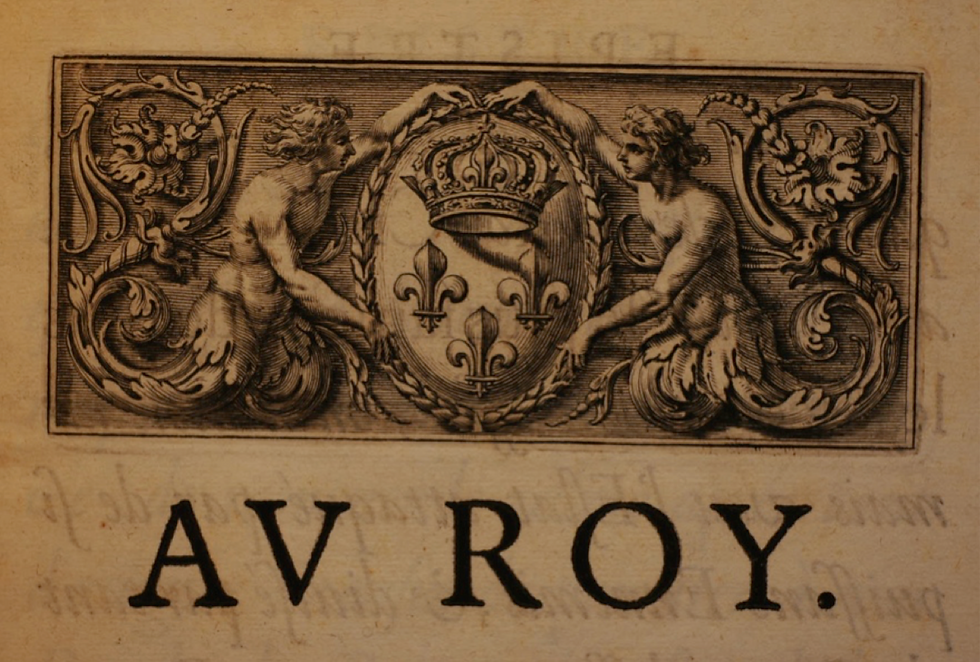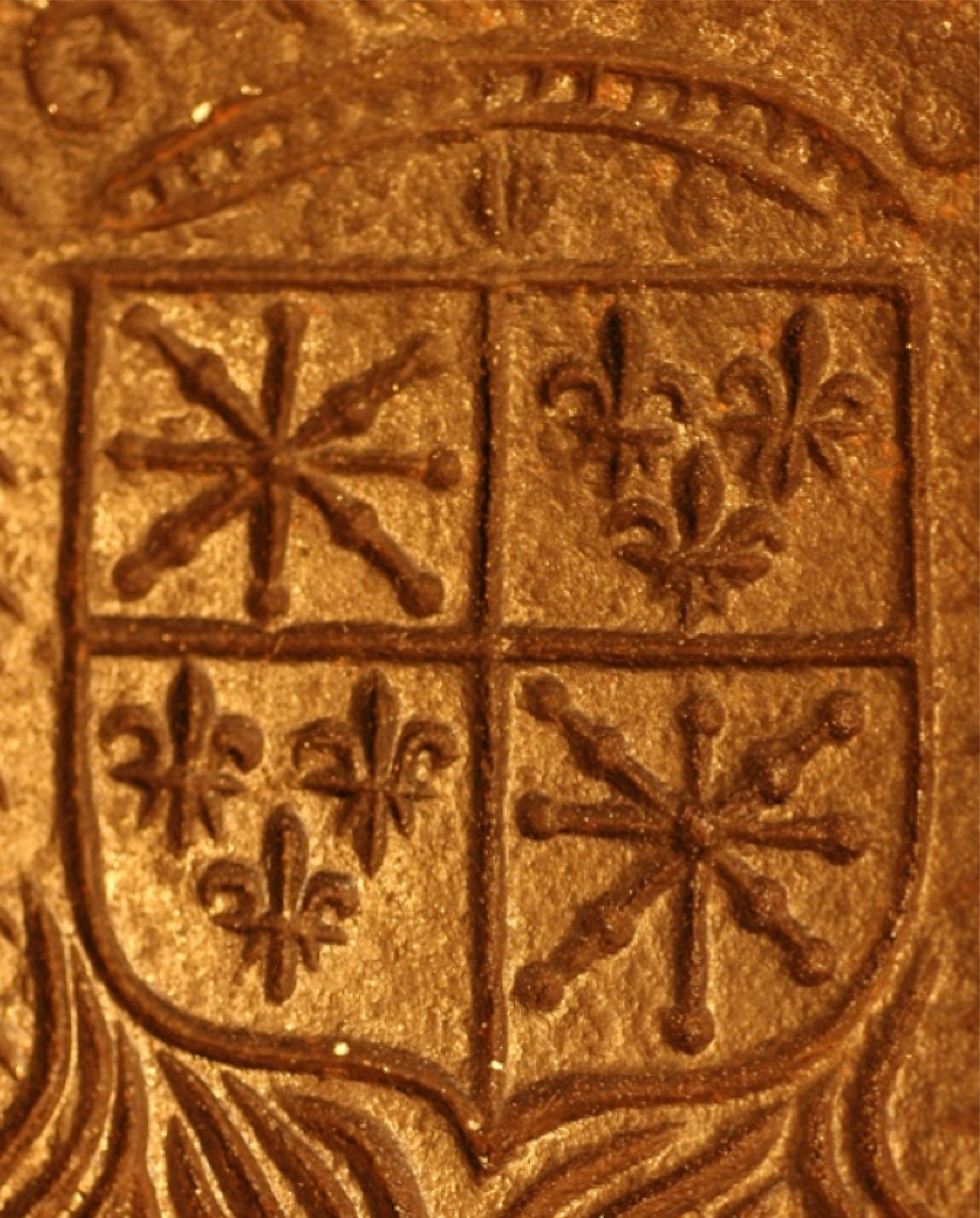Fleur-de-Lys, By Order of the King
- ancienttoolscollector
- Apr 15, 2018
- 6 min read
Updated: Mar 30, 2023

Figure 147 Au Roy, “To the King”, frontispiece of 1661 book published to celebrate the
two hundredth anniversary of the death of French King Charles VII in 1461
Many tools bear a Fleur-de-Lys symbol engraved or carved in their body or handle. Sometimes they display a whole series of them spread in a pattern. In other instances, they carry only one small Fleur-de-Lys hidden in the back of the tool or in a spot that’s barely visible. Where does the Fleur-de-Lys come from? What is the exact origin of this royal symbol? The answer may lie in the 5th century AD.

Figure 148 Fleur-de-Lys symbol on several tools: folding rule (Tool ref. #1200),
iron compasses (Tool ref. # 352), and plane (Tool ref. #1140)
French king Clovis (465-511 AD) holds a special place in the history of France. He established the first Frankish kingdom by conquering most of the regions that make up the domestic territory of France today and started the Merovingian dynasty that ran until king Childeric III in 751 AD. Legend has it that upon his conversion from pagan beliefs to Christianity, Clovis was given by an angel a lily flower as a symbol of his purification. According to historical accounts, the flower may have actually been given to him during his grandly celebrated baptism ceremony on December 25, 496 in the Reims cathedral. Hence, the French Catholic Church holds this event as a turning point in the religious history of France for Clovis was the first king to officially convert and make Catholicism the state religion. This is when the Fleur-de-Lys (it means literally lily flower) started to be represented on coins.
In a significant development for the Fleur-de-Lys, French king Louis VII (1120-1180) designated it as the crown’s heraldic symbol. His son, King Philip Auguste II (1165-1223) expanded its use as semis of golden flowers on a dark blue background specifically made to order (also known as the royal blue or “azure”). The yellow or golden Fleur-de-Lys semis on azure background became, by order of the king, the symbol of French royalty until the French revolution of 1789.

The Fleur-de-Lys can also be spotted for the first time on a French royal seal during the reign of Philip Auguste II. It stands at the end of his scepter and in his right hand on the royal seal. The symbol evolved over time as the royal signature. For example, in 1284, king Philippe VI Le Bel, Philip IV the Fair (1268-1314) had a seal made for his wedding where he is represented with his shield covered with Fleur-de-Lys and his horse draped in a long coat also printed with the Fleur-de-Lys semis. Upon his accession to the throne, in 1285, he had his royal seal represent him in a more traditional fashion: seated on his throne with a Fleur-de-Lys in the right hand, one at the end of his scepter, and a third one on his crown.
King Charles V Le Sage, Charles the Wise (1338-1380) had his seal designed with only three Fleur-de-Lys flowers arranged in a triangle and meant to represent the Trinity. King Charles VII (1403-1461) reigned from 1422 until his death in 1461. He introduced a royal honor roll at the French Court whereby only members of his family were entitled to wear a crest comprising three Fleur-de-Lys. An example appears below in Figure 150 for the Prince’s crown, son of France (“Couronne de Prince, Fils de France”). A select few noblemen were granted the privilege to wear two Fleur-de-Lys on their heraldic crest and even on their clothes. Finally, a single Fleur-de-Lys was given to someone as a special favor when the king was to acknowledge his thanks for a heroic act or service rendered to the kingdom.

Figure 149 Couronne de Prince, Fils de France (crown prince, son of France)
crest displaying the three Fleur-de-Lys symbols
The French royal symbol evolved again over time. As detailed in the chapter on Three Old Eucharistic Irons, when Henri de Navarre succeeded Henri III in 1589, he became Henri IV, king of France and of Navarre. To symbolically represent the new kingdom, he merged the respective arms into a new royal logo comprising the crossing chains of Navarre with the three Fleur-de-Lys of France. Details can be seen on the Eucharistic bread iron below in Figure 151.

Figure 152 is another historical representation of the royal crest comprising the three Fleur-de-Lys and chains of Navarre. The crown above the crest also bears three Fleur-de-Lys. It appears in the book written by Jean Chartier in 1661 by order of the king Louis XIV to celebrate the two hundredth anniversary of the death of King Charles VII. Another interesting representation in the same book is that of the cherub holding the two flags with the respective symbols as shown in Figure 153.

The Fleur-de-Lys bloomed all over Europe. Henry II of Plantagenet (1133-1189) appears to be the first king of England represented with a Fleur-de-Lys on his crown and scepter. Count William II of Holland (1228-1256) put four Fleurs-de-Lys (or “Lisblome” in Dutch) on his throne in the year 1250. In the same fashion, the first king of Germany, Rudolph of Hapsburg (1218-1291) had his seal redesigned in 1273 to include a “Lisch-Blum” (Fleur-de-Lys) at the occasion of his crowning as Holy Roman Emperor of Germany. Finally, in 1303, Pope Boniface VIII clarified in his writings that the Fleur-de-Lys symbolized the French kingdom and monarchy as per king Clovis’s choice in the 5th century. As the Fleur-de-Lys came to actually represent France, kings of England who laid a claim on the French throne usually included the Fleur-de-Lys semis on their shield. This first started with King Edward III (1312-1377) who invaded France in 1339. The event led to the beginning of the Hundred Years War. King of England Richard II (1367-1399), born in Bordeaux, negotiated a truce with France in 1396 but still claimed the French throne. He had the Fleur-de-Lys design on his royal shield as well. It is interesting to note that King Henry IV of England (1367-1413) followed Charles V the Wise in changing his own royal shield from the semis to the three Fleur-de-Lys triangular grouping because, he explained, France was part of England.

In 1431, king of England Henry VI even came to Paris with his uncle the Duke of Bedford and court dignitaries to have himself crowned as king of France while holding his second crown to clearly identify his dual kingdom. Only on November 11, 1800 did England definitely remove the Fleur-de-Lys from its flags and crests as an acknowledgement that it officially renounced its claims to the French throne.
After the French Revolution, under the rule of Napoleon Bonaparte (1769-1821) who reigned as Consul from 1799 until 1804 and as Emperor until 1814, a group of royalists remained faithful to the House of Bourbon which produced a French king lineage from king Henri IV in 1589 until king Louis XVII in 1795. They attempted to restore Louis XVIII (1755-1824) as king of France. Before they finally succeeded on April 11, 1814, royalists were tracked down without mercy by Napoleon’s regime supporters. The royalists had to meet in secret places and used the Fleur-de-Lys and the words “Vive le Roy” (long live the king) as their mean of recognition and allegiance symbols, generally hidden in the inside or handle of a tool or personal object such as a tobacco rasp as shown below in Figure 154.

Figure 153 Late 18th century tobacco rasp engraved with “Vive le Roy” (Tool ref. #1173)
This late 18th century tool was used to rasp fresh tobacco roots. It is made of soft iron engraved with the words “Vive le Roy”. Among Compagnons and masters, masons and other corporations who had worked for the kings for generations, it was increasingly difficult to work within the arcane systems of the new regime and constitution. That became even more critical after the Restoration when Louis Napoleon (1808-1873), Napoleon Bonaparte’s nephew was elected President of France and started the Second Republic. Many masons and Compagnons remained royalists during the late 18th century and first half of the 19th century. As testimony to this allegiance, many of their tools display the Fleur-de-Lys more or less prominently and sometimes hidden.

On the two compasses shown in figure 155, the Fleur-de-Lys is visible. However, on the 18th century iron bench screw below, it is hidden on the back of the screw that attaches to the bench so it could barely be discerned.

Other than to express the allegiance to the throne, Compagnons in various European countries used the Fleur-de-Lys to signify that their workmanship was warranted by royal commission and even as a signature of their own. This is best demonstrated by the tradition of Dutch planemakers to have a Fleur-de-Lys in between their initials for their engraved signature at the toe of the planes. Numerous examples can be seen in the chapter on Dutch Navigators and Traveling Tools. Below is the signature of Frans Moret on a 1745 Blokschaaf plane. It comprises a Fleur-de-Lys in between his initials.
















Comments